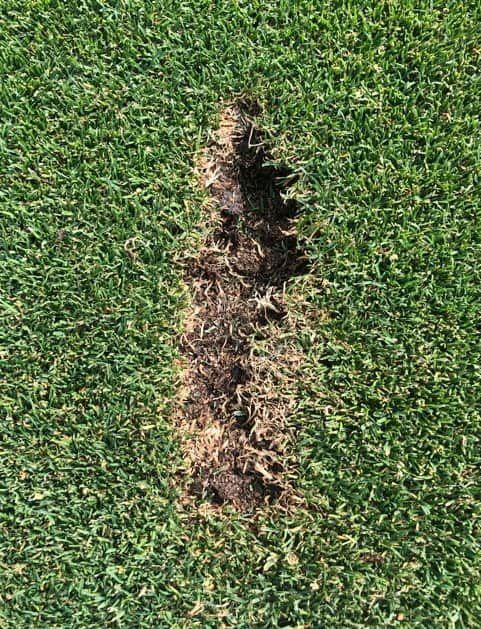Most everyone fixes ball marks and divots that they leave on the course, but are you fixing them properly so they will have the best chance to grow back in the shortest time? Sometimes you may think you’re fixing your divots but instead you are just covering them up and the grass will eventually die. I will show you how best to repair your divots so the grass will recover as quickly as possible.
Treat The Golf Course As If It Were Your Own
When I was the Head Golf Professional in Illinois, I felt like I was the owner of the golf course so I treated every inch of it as my own. I would fill every divot that I passed in the fairways. I would stuff the little basket on the backside of the golf cart with extra seed containers for my rounds and replace them with full ones when making the turn (if you don’t know what ‘making the turn’ means, check out my Golf Terms post).
The reason I did this was because I knew if I didn’t repair a divot, it could take an extra day, a week or even longer for it to repair and grow back. I truly appreciate the time and effort my maintenance staff puts in to keep the course conditions pristine.
Leave the Golf Course in Better Shape Than When You Found It
PSA notice! Golf has always been known as a gentleman’s game. So it’s common courtesy that when you take a divot, you should also take care of it. I believe if golfers saw others taking care of the course, they would do so themselves. Spread the love and our balls will never end up in a divot!
For those of us who are doing our part in repairing divots, let’s make sure we repair them properly so they have a chance to grow back quicker. Let’s get to it!
Repairing Divots
When making that crevice into the turf we have to identify a few factors before just filling it in or replacing it. The seed containers on your golf carts are usually intended for fairway divots only. Most superintendents mix in seed or fertilizer with the sand or soil to have it grow back quicker.
You first have to identify what kind of divot you made.
Identifying the Type of Golf Divot
- One-piece divot with roots still in tact with soil/dirt – Replace it
- Divot exploded with roots and turf spread out – Fill in divot hole with soil mix in container
- Divot combed over like a toupee but still attached – Just roll it back and step on it!
Divots made in the rough should usually be replaced unless the divot has exploded into pieces with no good root structure intact. That would also mean the roots are probably still in the ground below your divot so it should grow back. You can just take whatever bigger pieces and fill in the divot so no other ball falls into as much and to give it some shade to grow back faster.
Different Types of Golf Divots
There are a few different types of divots that players might encounter:
- Shallow Divot: A shallow divot is relatively small and doesn’t penetrate very deep into the ground. It often indicates good ball contact and a clean swing through the impact zone.
- Deep Divot: A deep divot is larger and penetrates deeper into the ground. It might suggest that the golfer’s angle of attack was steeper, potentially causing the club to dig into the turf more aggressively. Deep divots can be a sign of a descending blow on the ball.
- Thin Divot: A thin divot is one where the club strikes the ground with the leading edge or the bottom part of the clubface. This type of divot can result in a shot that doesn’t achieve the desired distance and trajectory.
- Fat Divot: A fat divot occurs when the golfer strikes the ground before making contact with the ball. This can lead to a chunked shot, where the ball doesn’t travel far and might not even get airborne.
- Toe Divot: A toe divot happens when the clubface strikes the ground closer to the toe of the club. This type of divot can result in a shot that fades or slices to the right (for a right-handed golfer).
- Heel Divot: A heel divot occurs when the clubface strikes the ground closer to the heel of the club. This type of divot can lead to shots that draw or hook to the left (for a right-handed golfer).
It’s important for golfers to pay attention to the type of divot they are making, as divots can provide valuable feedback about their swing mechanics and ball-striking tendencies. Consistently analyzing divots can help golfers make adjustments to their swing to improve ball contact, trajectory, and accuracy. Additionally, repairing divots on the fairway is a crucial aspect of golf course etiquette and helps maintain the course for the enjoyment of all players.


